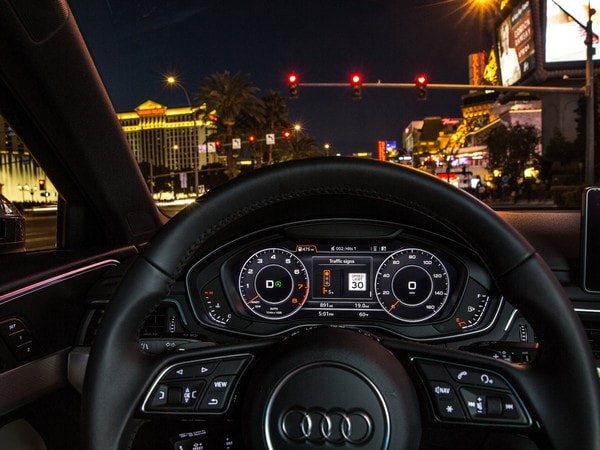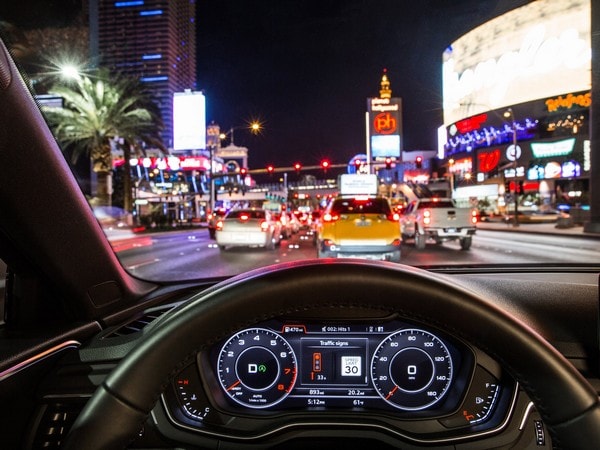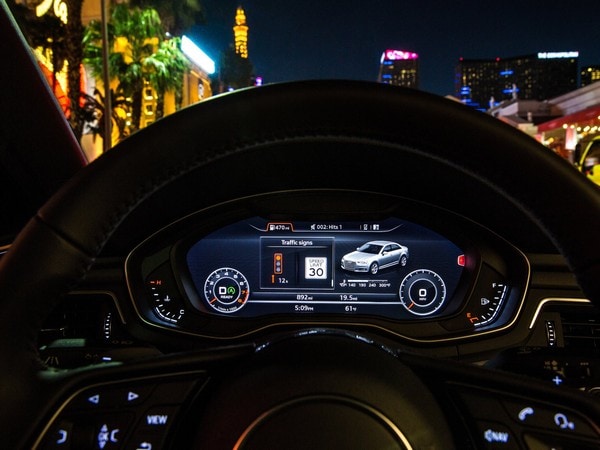
How many times have you wondered when—or even if—a traffic light would finally go from red to green? There’s a pre-teen civil war heating up in the back seat, the gas gauge needle is perilously close to E, you’re running late, the seconds seem to stretch into hours, and that light remains red, as though had always been red and would never change.
Audi’s latest technological advance proposes to reduce some of that anxiety out of the wait with a dashboard and/or head-up display (in vehicles so equipped) that counts down the duration of the red light. The benefit, according to Audi, is stress reduction—the driver can relax until it’s time to actually get the vehicle moving. No more tense anticipation, like a driver waiting for the countdown of the Christmas tree lights at a drag strip.
And during the wait for longer lights, the driver has an opportunity to do a little multi-tasking—a swallow from that rapidly cooling coffee for example, or a chance to put more force into family peacekeeping: “do not make me come back there.”
At a minimum, knowledge that the light will indeed change, and when, allows the driver a sense of tolerable resignation. Audi calls it “informed waiting.” The enabler is called V2I, for Vehicle-to-Infrastructure, a U.S. connectivity first, according to Audi. The technology allows the vehicle’s on-board Audi Connect 4G LTE system to receive cloud-based real-time information from metropolitan traffic management systems. And the first application of this technology is a traffic signal countdown service–Audi Traffic Light Information.
Also: Kelley Blue Book Best Buy Awards of 2017
Uniquely Vegas
Audi’s long-term goal is to eventually make the traffic light info broadly available in as many major urban areas as possible, a harbinger of more comprehensive services in the future based on the same vehicle-to-infrastructure technology—stop/start system management, for example, as well as navigation.
Some 10 cities are being considered for V2I, according to Anupaum Malhatra, Audi’s Director of Connected Vehicles. All the target cities have robust Audi sales, and Las Vegas is the first, beginning before the end of 2016. Audi wasn’t ready to identify any other target municipalities, although Malhatra said other cities could be ready to go in as little as “two or three months.”
Does Las Vegas seem an unlikely starting point? Not to Audi. For one thing, Audi was the first to be granted a permit for public highway autonomous vehicle development by Nevada. For another, and more pertinent, most traffic signals in southern Nevada, which includes a half-dozen local governmental agencies, are controlled by a single source—the Regional Transportation Commission (RTC) of Southern Nevada.
The RTC coverage includes 1,751 intersections, which can entail as many as 20 to 30 individual traffic lights per intersection. It also includes most of the region’s 2.1 million permanent residents and pretty much all of its 42.3 million annual visitors.
Kiel Ova, chief marketing officer of Traffic Technology Services (the company developing the enabling software) says the single-source RTC makes this area uniquely conducive to the Audi program. When there are multiple agencies with separate—and sometimes overlapping—traffic management programs, the programming becomes much more challenging. The greater Los Angeles-Orange County area, for example, looms as a digital jigsaw puzzle with 115 different traffic management agencies.
There are three general types of traffic signals. Fixed interval lights—the duration is always the same. Variable lights—the durations vary depending on time of day. Finally there are coordinated lights, which change on a basis of situational variables, such as traffic volume at a particular time.
Also: Class of 2017 — New Cars Ready to Roll
Testing, testing
After presentations by Audi and Angela Castro of RTC, we were given a chance to experience Traffic Light Information in and around metro Las Vegas.
The short version—it works. Some lights in the so-called Las Vegas strip area can run as long as 160 seconds, and there’s something comforting about watching the declining numbers as the system counts down. The numbers disappear when the countdown reaches four seconds, alerting the driver that it’s time to begin driving again, and also giving drivers of cars with stop-start technology a chance to get their engines running before the light actually turns green.
It will also tell the driver whether or not a distant light will turn red before he or she arrives. And if the driver gets in a left turn lane with turn signal activated, it can differentiate the wait time between the left turn signal light and the adjacent straight-ahead lights.
The long version—it works, but there are asterisks. For example, the system is pegged to local speed limits. Exceed the speed limit by more than about 5 mph, and the countdown display disappears. In the Las Vegas drive running at the speed limit meant that most traffic was whistling by our demonstration car. Also, the system can be superseded by pedestrian crosswalk signals, and emergency vehicles, although this is obviously a reasonable priority.
Beyond that, at launch Vehicle-to-Infrastructure feels more like a trial than a major technological breakthrough. It’s limited to the southern Nevada metro area, with no specifics about where and when it will be launched next. And it is further limited by which Audi vehicles will be equipped to offer the service. Initially that list includes the 2017 A4 and Q7 SUV, plus Audi Allroad models.
And it’s only available in models with Audi Connect Plus, the premium version of three infotainment programs, which includes the required 4G LTE software and is a subscription service with several price plans. The next chapter should broaden the scope as Audi adds new vehicles and metro regions to the program. We’ll be tracking progress with interest.










